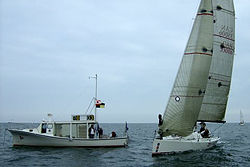 Yacht racing is the sport of competitive sailing. There is a broad variety of kinds of races and sailboats used for racing. Much racing is done around buoys or similar marks in protected waters, while some longer offshore races cross open water. All kinds of boats are used for racing, including small dinghies, catamarans, boats designed primarily for cruising, and purpose-built raceboats. The Racing Rules of Sailing govern the conduct of yacht racing, windsurfing, kitesurfing, model boat racing, dinghy racing and virtually any other form of racing around a course with more than one vessel while powered by the wind.
Yacht racing is the sport of competitive sailing. There is a broad variety of kinds of races and sailboats used for racing. Much racing is done around buoys or similar marks in protected waters, while some longer offshore races cross open water. All kinds of boats are used for racing, including small dinghies, catamarans, boats designed primarily for cruising, and purpose-built raceboats. The Racing Rules of Sailing govern the conduct of yacht racing, windsurfing, kitesurfing, model boat racing, dinghy racing and virtually any other form of racing around a course with more than one vessel while powered by the wind.Harbour or buoy racing
Harbour or buoy races are conducted in protected waters, and are quite short, usually taking anywhere from a few minutes to a few hours. All sorts of sailing craft are used for these races, including keelboats of all sizes, as well as dinghies, catamarans, skiffs, sailboards, and other small craft. A competition, or regatta, usually consists of multiple individual races, where the boat that performs best in each race is the overall winner. The most famous such event is the America's Cup, but harbour races are common anywhere there is a community of sailors. A notable example is found in Bermuda, where the Bermuda rig, now almost universally-used on small sailing vessels, can still be seen in its purest form in the Bermuda Fitted Dinghy, used for a series of races contested each year by the colony's yacht clubs. Bermuda also played a role in the development of the International One Design.
This kind of race is most commonly run over one or more laps of a triangular course marked by a number of buoys. The course starts from an imaginary line drawn from a 'committee boat' to the designated 'starting' buoy or 'pin'. A number of warning signals are given telling the crews exactly how long until the race starts. The aim of each crew is to cross the start line at full speed exactly as the race starts. A course generally involves tacking upwind to a 'windward' marker or buoy. Then bearing away onto a downwind leg to a second jibe marker. Next another jibe on a second downwind leg to the last mark which is called the 'downwind mark' (or 'leeward mark'). At this mark the boats turn into wind once again to tack to the finish line.






Комментариев нет:
Отправить комментарий